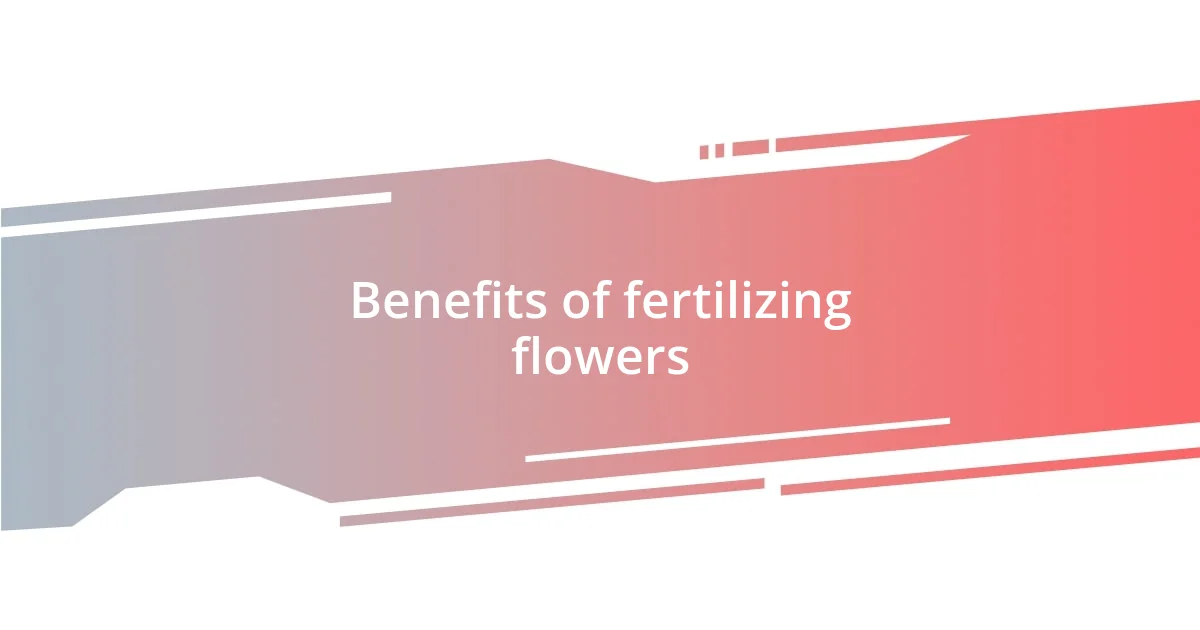Key takeaways:
- Each flower type has specific needs for humidity, watering, light, and pruning, which must be understood for them to thrive.
- Choosing the right flowers involves considering climate suitability, sunlight requirements, water needs, and maintenance levels.
- Proper watering techniques, ideal light conditions, and timely fertilization significantly enhance flower health and garden aesthetics.

Understanding flower needs
When it comes to understanding flower needs, it’s essential to recognize that each type of flower has its own unique requirements. For instance, I remember bringing home a stunning orchid, only to find its leaves drooping just days later. It turned out that orchids prefer a humidity level much higher than what my living room offered. Can you relate to the stress of trying to save a beloved plant after realizing you underestimated its needs?
Watering is another crucial aspect to consider. I’ve learned the hard way that overwatering can be just as detrimental as underwatering. When I noticed my peace lily’s leaves turning yellow, I realized how important it is to test the soil before reaching for the watering can. Have you ever thought about how a simple habit like checking the soil moisture can transform your flower care routine?
Light conditions play a vital role in a flower’s health, too. After moving my succulents from a bright windowsill to a shadier spot, I was shocked to see them stretch towards the light; it was like they were pleading for more sun! This experience taught me the importance of providing the right type of light, and it made me wonder—have you truly assessed how much light your flowers receive each day? Understanding these specific needs can create a thriving environment for your plants.

Choosing the right flowers
Choosing the right flowers can truly make or break your gardening experience. I recall visiting a local garden center, completely enchanted by vibrant blooms but completely oblivious to their needs. I ended up bringing home a beautiful but finicky peony, which turned out to be a challenge for my climate. That experience taught me to consider not just the aesthetics but also the compatibility of flowers with my environment.
Here are some key factors to keep in mind when choosing flowers:
- Climate suitability: Research flowers that thrive in your specific climate zone.
- Sunlight requirements: Ensure the flowers you choose match your garden’s light conditions—some love full sun, while others prefer shade.
- Water needs: Consider whether the flowers require consistent moisture or prefer drier conditions; this can prevent countless headaches.
- Seasonality: Invest in flowers that will bloom during different seasons for year-round joy.
- Maintenance levels: Some flowers demand more care than others, so choose according to your availability and commitment.
A simple misstep in choosing flowers can lead to frustration, as I’ve personally learned. It’s all about striking the right balance between beauty and practicality.

Best watering practices
When it comes to watering, timing is everything. I found out the hard way that watering in the evening can lead to damp soil overnight, which encourages root rot. Now, I prefer watering in the morning when the sun is still low. It allows the plants to absorb moisture throughout the day without promoting fungal growth. Have you ever noticed the difference a simple change in timing can make?
I’ve also come to appreciate the importance of techniques like deep watering. Instead of a quick splash, I let the water soak in slowly. This method encourages deep root growth and makes for healthier plants. I remember watching my newly planted lavender thrive after giving it a long, slow drink instead of just a quick spray. It’s fascinating how this adjustment can truly enhance a flower’s vitality!
Lastly, the water quality should not be overlooked. I’ve noticed that my flowers thrive when I use room temperature water rather than cold water straight from the tap. Cold water can shock the roots and hinder their ability to absorb nutrients effectively. As part of my routine, I set aside a watering can with tap water to reach room temperature, and it has made a noticeable difference. How do you usually prepare your watering routine?
| Watering Method | Description |
|---|---|
| Timing | Water in the morning to prevent root rot |
| Technique | Deep watering promotes healthy root development |
| Water Quality | Room temperature water is better than cold water |

Ideal light conditions
Finding the right light conditions for your flowers is crucial for their success. I’ve learned this lesson after watching a beautiful hydrangea struggle in a dim corner of my garden. It wasn’t until I moved it to a spot where it could bask in the morning sun that it flourished. Have you ever considered how a simple change in light can transform your plants’ health?
Different flowers have distinct light needs, which can be a bit overwhelming. Some thrive in full sun, soaking up every bit of warmth, while others prefer the comfort of partial shade. For instance, I’ve had great success with my petunias in bright, direct sunlight, but my ferns look their best in shadier spots. Understanding these preferences not only enhances the beauty of your garden but also reduces frustration and disappointment.
Additionally, I’ve discovered the importance of observing how light changes throughout the day. It’s amazing to see how the sun’s trajectory affects my garden—what was once a sunlit paradise could turn into a shadowy retreat by afternoon. I often find myself thinking about how something as simple as a tree nearby can create a microclimate. Are you paying attention to the changes in your garden’s light?

Importance of proper pruning
Proper pruning is essential for maintaining healthy flowers and enhancing their growth. I remember my first attempt at pruning a rose bush; I was hesitant and ended up snipping far too little. The result? A bush that bloomed sparsely. Over time, I’ve realized that strategic pruning encourages new growth and vibrant blooms. Isn’t it interesting how a simple cut can rejuvenate a plant, almost like hitting a reset button?
Moreover, pruning can help prevent diseases by promoting better air circulation. I once neglected to prune my peonies, and they became prone to powdery mildew. Now, I make it a habit to trim them back, allowing for airflow that keeps diseases at bay. Recognizing the signs of overgrowth not only helps the plants thrive but also makes the garden look tidy. Have you experienced the benefits of a well-pruned garden?
I’ve also learned that timing is everything when it comes to pruning. Each flower has its prime moment for a trim, and I’ve become quite adept at identifying these windows. For example, September has become my go-to month for cutting back shrubs before winter sets in. It’s a small effort that pays off with a burst of color come spring. What timing works best for your garden?

Benefits of fertilizing flowers
Fertilizing flowers brings a boost that can truly transform your garden. I remember a time when I decided to skip fertilizing my daisies, thinking they’d be fine on their own. The result was less than stellar—fewer blooms and a rather sad-looking patch. After incorporating a balanced fertilizer into my routine, the difference was astonishing. Have you ever seen how a little nourishment can revive tired plants?
One of the key benefits of fertilizing is that it replenishes the nutrients in the soil, which can get depleted over time. Each flower has specific nutritional needs, and I’ve found that understanding these can significantly impact growth. For instance, my snapdragons absolutely thrive when I use a phosphorus-rich fertilizer, leading to more vibrant and larger flowers. What types of blooms do you think could benefit from a nutrient boost?
I’ve also discovered that fertilizing can encourage flowering at the right times, making your garden more visually appealing. There was a season when my marigolds bloomed out of sync, leaving gaps in color where they should have flourished. After I began fertilizing at strategic intervals, I was thrilled to see them bloom beautifully and consistently. Isn’t that a rewarding sight? It’s amazing how a little extra care can lead to a garden bursting with life.















